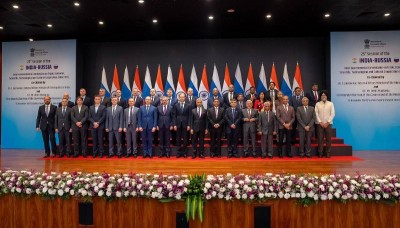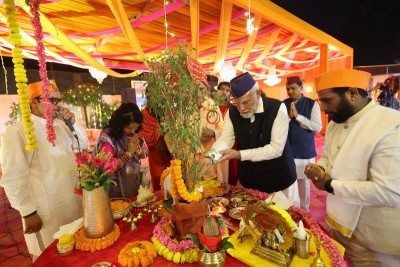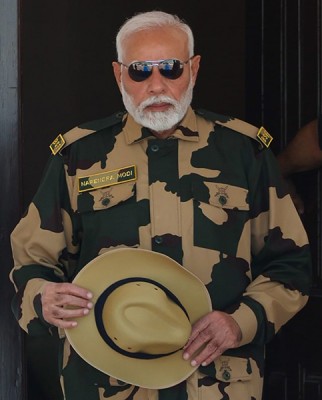
Maharashtra: Rebellion Halted
In the intervening night of February 1 and 2, 2019, two villagers, identified as Nirmal Goswami and Samru Kosmi, were shot dead by Communist Party of India-Maoist (CPI-Maoist) cadres, over suspicion of being ‘Police informers’, near Markegaon village in Dhanora Tehsil (revenue unit) in Gadchiroli District. Superintendent of Police (SP) Shailesh Balkawade disclosed,
The Maoists had left a pamphlet saying the two were passing on information to the Police. That’s not true. They were not our informers. We always accept when there is anyone who is really our informer since we have to take care of the family under government scheme.
On January 30, 2019, a villager, identified as Wale Vanja Kudyami, who was abducted by CPI-Maoist cadres over suspicion of being a ‘Police informer’, was found dead at Pengunda Phata under Bhamragad taluka (revenue sub-division) in Gadchiroli District. Kudyami was abducted by Maoists along with his wife seven days ago, but the latter was subsequently freed, according to the Police. A note was found near his body, which alleged Kudyami was killed because he was a ‘Police informer.’
On January 27, 2019, a villager, identified as Sansay Tanu Beig (32), who was abducted by a group of CPI-Maoist cadres over suspicion of being a ‘Police informer’, was found dead in Jaravandi village under Etapalli Tehsil in Gadchiroli District. The victim had been abducted late on January 26.
On January 22, 2019, three villagers were shot dead by CPI-Maoist cadres on suspicion that they had passed on tip-offs to the Police that led to a massive anti-Maoist operation in which 40 rebels were killed in 2018, in Gadchiroli District. A group of around 150 armed Maoists from Chhattisgarh, who entered Kasansoor village near Kosfundi Phata in the Bhamragad taluka of the District, abducted six villagers – Dalsu Devu Pungati, Munshi Gahe Madavi, Vinu Devu Talandi, Malu Dhogo Madavi, Kanna Rainu Madavi, and Lalsu Kudyeti. Later, the bodies of Malu Madavi, Kanna Madavi, and Lalsu Kudyeti were thrown near the Kosfundi diversion on the Tadgaon-Bhamragarh Road. The whereabouts of the remaining three villagers were not known. Some Maoist pamphlets were recovered from the spot stating that the CPI-Maoist would be carrying out a campaign against ‘SAMADHAN’, an anti-Maoist initiative of the Central Government, during their (Maoists’) ‘Martyrs week’, from January 25 to January 31. The pamphlets also carried an appeal for villagers to observe ‘Bharat Bandh’ (all India shut down) on January 31. Between January 25 and 31, apart from killing five civilians in three incidents, the Maoists set at least seven vehicles on fire at two different places (Kurkheda Taluka and Gadchiroli Taluka) in the Gadchiroli District. The Maoists also blocked traffic on Korchi-Kurkheda road in the District by felling trees.
It is useful to recollect that Security Forces (SFs) had killed at least 40 Maoists in twin encounters in the Boriya forest area under Bhamragad Tehsil in Gadchiroli District in the intervening night of April 22 and 23, 2018.
The recent spree of civilian killings in the State is indeed an indicator that the Maoists are frustrated with continuing losses in the State in particular and the country at large.
According to partial data compiled by the South Asia Terrorism Portal (SATP), Maharashtra recorded 58 fatalities, including five civilians, two Security Force (SF) personnel, and 51 Maoists, in Maoist-related violence in 2018. In 2017, there were a total of 25 fatalities, including seven civilians, three SF personnel, and 15 Maoists. A total of eight Maoist-linked fatalities have been recorded in the State thus far in 2019 (data till February 3, 2019), including seven civilians and one Maoist.
A cursory analysis of fatalities suggests that, while militant fatalities increased significantly by 240 per cent in 2018, in comparison to 2017, fatalities in the SF category registered a decline of 33.33 per cent.
Significantly, SFs achieved a kill ratio of 1:25.5 in 2018, when SFs killed 51 Maoists, while losing just two of their own personnel, a dramatic improvement over the kill ratio of 1:5 in 2017, when SFs killed 15 Maoists, losing three of their own personnel. The kill ratio of 1:6 in 2016 also favoured the SFs, as they killed 12 Maoists, losing two of their own personnel. SFs recorded an adverse kill ratio twice –1.1:1 in 2014 and 2:1 in 2015, in the last five years.
An analysis of civilian fatalities over the years indicates a cyclical trend, with a peak of 34 in 2011 and a low of two, twice, in 2005 and 2008. Indeed, civilian fatalities in 2011 were the highest ever recorded since the formation of CPI-Maoist in September 21, 2004. The Maoists have already killed seven civilians in the current year, thus far (data till February 3, 2019).
Though, the number of major incidents (each resulting in three or more fatalities) in 2018 increased to three, as compared to just one in 2017, in both years the Maoists were badly battered. On April 23, 2018, six CPI-Maoist cadres were killed by SFs in an encounter at Rajaram Khanla village in Aheri Tehsil in Gadchiroli District; on April 22, 2018, 34 CPI-Maoist cadres were killed by the C-60 commandos of the Gadchiroli Police and personnel from Battalion 9 of the Central Reserve Police Force (CRPF) in Boriya Forest in Bhamragad Tehsil of Gadchiroli District; and, on April 3, 2018, three CPI-Maoist cadres, including two women, were shot dead during an encounter with SFs in the Srikonda Forest under Jhighanoor Police Station limits in Gadchiroli District. In 2017, on December 6, seven CPI-Maoist cadres, including five women, were killed in an encounter with SFs near Kalled village, 15 kilometres north of the Zinganoor Police Station in the Sironcha Tehsil of Gadchiroli District.
Geographically, all fatalities, indeed, all Maoist activities in 2018 and 2017, remained confined to Gadchiroli, the epicentre of Maoist violence in Maharashtra. Unsurprisingly, the Union Ministry of Home Affairs (UMHA) on August 1, 2018, identified Gadchiroli as one among 30 ‘worst Maoist-affected’ Districts across seven States in the country.
Meanwhile, at least 10 Maoists were arrested in Maharashtra in 2018, in addition to 11 in 2017, according to the SATP database. Some of the most significant arrests of 2018 included Rammana aka Shrinivas Vitthalanna Madru aka Ravi aka Suresh (65), along with his wife Padma Kodape aka Sammakka aka Lata (55), from Ballarshah town of Chandrapur District on February 9. Rammana headed the technical department of the CPI-Maoist in Chhattisgarh and was associated with the Maoist movement since 1976-77. Rammana also known as ‘Tech Ramanna’ carried a reward of INR 2.5 million on his head. Padma was working for the CPI-Maoist since 1992 and carried a reward of INR 600,000, and was believed to be involved in violent incidents in Madhya Pradesh, Chhattisgarh, and Maharashtra.
Mounting SF pressure also led to the surrender of 17 Maoists in 2017, adding to 11 such surrenders reported in 2017. Significantly, on May 2, 2018, Jyoti aka Raveena Joga Pudyami (26), a ‘deputy commander’ of Mangi Dalam (armed squad) in Telangana, carrying a reward of INR 400,000 on her head, surrendered to the Police in Gadchiroli District; on March 28, 2018, Sainu aka Margu Velda, a ‘company commander’ and Rupi aka Jhuri Narote, a ‘platoon commander’ of the CPI-Maoist, along with three other cadres (Arjun Naresh Barsai Poya, Chaya alias Raje Devi, and Vinu alias Ramnath Bijou Sundar Kovachi) surrendered to the Police in Gadchiroli District; and on February 7, 2018, Jaya aka Shanti Masu Mattami, ‘deputy commander’ of Platoon No.14 of the People’s Liberation Guerrilla Army (PLGA), surrendered to the Police along with Ranita aka Sunita Namdev Kodape in Gadchiroli District. Mattami carried a reward of INR 400,000 on her head, and was wanted in 29 cases, including 11 murder cases, six cases of arson, and 12 cases of attack on Police teams, Kodape was an accused in eight cases of murder, four cases of arson, and 11 cases of attack on Police teams in the District and carried a reward of INR 200,000 on her head. Seven Maoists carrying a total cash reward of INR 3.15 million on their heads have already surrendered in 2019 so far (data till February 3, 2019).
According to a July 4, 2018, report, a CPI-Maoist document recovered by SFs mentioned that all the single-target actions in 2018 under the Tactical Counter-Offensive Campaign (TCOC) had ‘failed completely’, with increased visibility and mobility of SFs, especially in Gadchiroli. The document expressed worries about their own (Maoist) operations.
The State, meanwhile, initiated several measures in 2018, in addition to those taken in the past. According to a March 12, 2018, report, the Committee for Integration and Co-ordination under the Unified Command Mechanism, headed by Maharashtra Chief Minister Devendra Phadnavis, was formed to ensure multi-agency co-ordination for faster-decision making and implementation of various projects. To strengthen the network of the Police, and also to boost confidence of other departments to carry out developmental works, the State Home Department also announced a decision to offer a job to one family member of each of the ‘Police Informants’ killed by the Naxals in Gadchiroli District.
In another, though misdirected, effort, the Pune Police ‘uncovered’ an alleged ‘urban Maoist conspiracy’, arresting 10 ‘urban Maoists’: five (Surendra Gadling, Shoma Sen, Mahesh Raut, Sudhir Dhawale, and Rona Wilson) on June 6, 2018, and another five (Sudha Bhardwaj, P Varavara Rao, Gautam Navlakha, Arun Ferreira and Vernon Gonsalves) on August 28, 2018, from different parts of the country. All 10 were charged for inciting the Bhima Koregaon violence between Dalits and upper castes on January 1, 2018, and an incredible plot to assassinate the Prime Minister Narendra Modi. The Pune Police on November 15, 2018, filed charge sheets against five accused (Gadling, Sen, Raut, Dhawale, and Wilson) who were arrested in June over their alleged role in the Bhima Koregaon violence. The other five activists are currently being kept under house arrest, following the Supreme Court’s order of August 29, 2018. On January 30, 2019, the Gadchiroli Police took custody of Rao and Gadling from Pune’s Yerawada Central Jail in connection with an Unlawful Activities Prevention Act (UAPA) case related to the December 23, 2016, Maoist attack at Surjagarh in Gadchiroli District, in which around 80 vehicles were torched at the mining site by Maoists. The courts have chosen to give credence to the Police claims – filed in a five thousand-page chargesheet – and have denied bail to the accused.
Several parameters of violence indicate that the Maoists retain operational capabilities, though significantly depleted, for a revival in Maharashtra. The Maoists have been involved in 10 incidents of exchange of fire with the SFs through 2018, in addition to 11 such incidents in 2017. Six incidents of arson were reported in 2018 in addition to one such incident in 2017. The Maoists engineered one incident of an Improvised Explosive Device (IED) blast in 2018, in addition to two such blasts in 2017. Further, two incidents of abduction, in which 12 civilians were abducted, of which two were killed while others were released after ‘warnings’, were reported in 2018; in addition to one such incident, in which one civilian was abducted and subsequently killed, was reported in 2017.
Further, according to a November 17, 2018, report, Intelligence Agencies have warned that the CPI-Maoist are trying to build new bases along the shared border of Chhattisgarh-Maharashtra-Madhya Pradesh. The Maoists plan to develop ‘Jan Militia (people's militia)’ or underground fronts among local villagers and have chosen 100 villages under their Gondia-Rajnandgaon-Balaghat ‘division’ for the purpose. Accordingly, Left-Wing Extremist (LWE) outfits have largely consolidated along the Chhattisgarh-Maharashtra-Madhya Pradeshtri-junction, having organised multiple training camps for expansion in the future. The report also claimed that one ‘division’ has been found active in bordering areas of Balaghat (Madhya Pradesh), Rajnandgaon (Chhattisgarh), and Gondia (Maharashtra). Acknowledging the development, one UMHA official working in the LWE wing, disclosed,
We are keeping eyes on these developments, like what is the scale of Maoist activities in these areas and what is the current Security Forces deployment in the tri-junction of Chhattisgarh-Maharashtra-Madhya Pradesh borders and or if there are any gaps…
According to Bureau of Police Research and Development (BPR&D) data (as on January 1, 2017), though Maharashtra’s Police-population ratio, at 186.48 per 100,000, is significantly higher than the national average of 150.75, it remains substantially lower than the minimum of 220:100,000 regarded as desirable for 'peacetime policing'. The State has 225,475 Policemen against a sanctioned strength of 240,224 Policemen. The Police/Area Ratio (number of Policemen per 100 square kilometres) for Maharashtra is 73.27, as against the sanctioned strength of 78.07. The all-India ratio is 60.83, as against a sanction of 77.83 per 100 square kilometres.
Critical issues relating to State Police capacities also persist, though these are not as acute as they are in many of the other LWE-affected States. According to a February 5, 2018, report, over 30 per cent of the 4,600 bulletproof jackets received by Maharashtra Police failed the AK-47 bullet test during trials. These jackets were primarily meant to be used by Police Personnel during anti-Maoist operations in Gadchiroli District and in other areas, the Quick Response Team (QRT) of Mumbai Police, and Force One, the elite commando force raised after the 2008 terror strikes. The State Police started receiving the consignments of jackets in the last quarter of 2017. The then Additional Director General of Police, Procurement and Coordination), V.V. Laxminarayana had then stated, “We have sent back 1,430 bulletproof jackets to the manufacturer as they did not pass our test with AK-47 bullets." No follow up information is available in this regard.
Despite the SFs remarkable success in Maharashtra, particularly in Gadchiroli, critical security gaps in capacities and deployment remain. Gadchiroli and its neighbouring Districts, Gondia, Bhandara and Chandrapur, as well as Yavatmal beyond, were areas of an escalating security challenge just years ago. Extreme care and sustained focus will be necessary to ensure that the operational gains and dominance now established by SFs are consolidated further, the secure enduring peace and stability in this troubled and long-neglected region.
Support Our Journalism
We cannot do without you.. your contribution supports unbiased journalism
IBNS is not driven by any ism- not wokeism, not racism, not skewed secularism, not hyper right-wing or left liberal ideals, nor by any hardline religious beliefs or hyper nationalism. We want to serve you good old objective news, as they are. We do not judge or preach. We let people decide for themselves. We only try to present factual and well-sourced news.







